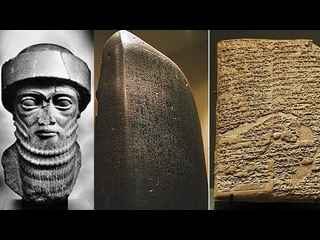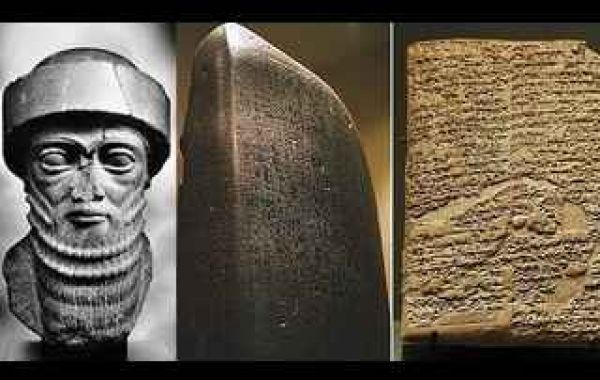The laws of King Hammurabi - the history of creation
Hammurabi (1792-1750 BC) was one of the most famous kings of Babylon. He is known to history not only as a great legislator, but also an equally great conqueror. At the beginning of his reign, the territory of the Babylonian kingdom was relatively small, in addition to the capital, it included only a few small cities, and there were by no means friendly neighbors around. Can Hammurabi be considered a wise and talented ruler?
But thanks to a number of successful military campaigns, and sometimes various cunning tricks, bribery and deals, King Hammurabi managed to expand the territory of Babylonia at times, conquer all nearby neighbors, and, in the end, unite the whole of Mesopotamia under his rule.
Hammurabi was an outstanding politician, strategist, military leader, under whom ancient Babylon reached the pinnacle of its power. Therefore, it is not surprising that contemporaries saw in him a divine chosen one, whose righteousness could not be disputed. The royal power was absolutely and one-man, the king was considered the highest authority and source of law and justice.

As a wise ruler, Hammurabi understood perfectly well that a large state could be ruled only with the help of a strict and fair order. For this purpose, he created the famous code of laws, called the laws of Hammurabi.
How the laws of Hammurabi were written
The laws of the Babylonian king were carved on a special cone-shaped stele. At the top, this stele was crowned with a bas-relief, on which two figures were depicted:
- sitting on the throne, the supreme god of the Babylonian pantheon - Shamash, personifying the Sun (read about parhelium - the phenomenon of a false sun);
- and the second figure standing with reverence before the deity is, most likely, Hammurabi himself, God's chosen one.
This stele with laws carved on it was lost for many centuries, and only in 1901 it was discovered by a French archaeological expedition led by Egyptologist Jacques de Morgan.
The text of the laws is carved on the stele in cuneiform in Akkadian. Short columns of cuneiform cover the front of the bas-relief and the entire back. Unfortunately, part of the text of the stele has not survived, historians suggest that it could have been destroyed by the Elamites, who captured the stele during one of their raids on Babylon during the decline of the Babylonian kingdom.
However, after deciphering the surviving text, the laws of the ancient Babylonian king appeared to historians in all their glory.
Hammurabi's laws - general characteristics
The first thing that catches your eye is that the laws of Hammurabi are carefully thought out and structured, which suggests that their compiler was a very pedantic person who loved order in everything, yes, that was the king of Hammurabi. The structure of the code includes an introduction, body and conclusion.
The main body has 282 paragraphs. 35 of them were erased by the Elamites, but not everything is so bad, scientists managed to restore them from another source - clay tablets found in Susa in the library of the Assyrian king Ashurbanipal in Nineveh.
This enlightened Assyrian king conceived of creating the largest library in the world, and his scribes documented all noteworthy written records of the ancient East. They also rewrote the Hammurabi Code of Laws, and thus made it possible to restore it completely.
The laws of Hammurabi cover all spheres of human life, their structure is as follows:
- Articles 1-5 - are devoted to the court and legal proceedings.
- Articles 6-126 are devoted to property rights and contractual relationships.
- Articles 127-195 - are devoted to family relations and the right of inheritance (in fact, this is the family code).
- Articles 196-214 are devoted to crimes of a criminal nature (and this is already a criminal code).
- Articles 215-282 are devoted to property crimes.
The prologue and epilogue are written in a hymn-epic style. The prologue glorifies the power of King Hammurabi as God's chosen one, and the epilogue speaks of divine support for those who follow this code of laws, and divine punishment for those who violate it.
Basic laws of Hammurabi
Now let's take a quick look at some of the most interesting laws of King Hammurabi from this code and their essence:
- If someone accuses another of a particular crime, and cannot prove it, then he himself should be punished accordingly. Even if the punishment for the crime is the death penalty, then the unjustly accuser must then himself be executed. (Harsh but fair.)
- If a judge changes his decision without reason, then he is deprived of the title of judge (without the right to occupy it in the future) and pays a large fine. (Such a law would not hurt our judges, do you think?)
- For theft from a palace or temple, as well as for robbery and looting during a fire, war or other disaster, the most severe punishment was imposed - the death penalty.
- For an ordinary theft, the caught thief had to compensate for the damage tenfold. If he could not do this, then again he was subject to the death penalty.
- In criminal proceedings, the principle of "tooth for tooth, eye for eye" was in effect. That is, if someone broke someone's hand, then as a punishment for this, his arm would also break. The punishment for murder was murder, that is, the death penalty.
- The property of a captured soldier was protected by a special law, it was inviolable and was returned to him upon the release of the soldier.
A number of articles of the code regulate property relations between the owner and the lessee of land. For example, according to one of the laws, the tenant is responsible for the uncultivated land. If there is one, then he pays a fine to the owner of the land in the amount of one crop that could have grown on this uncultivated land.
The laws of Hammurabi in the field of family law are very interesting:
- Adultery and rape were punishable by death.
- The wife of a warrior who was captured and experiencing material need was officially allowed to remarry, but when the first husband was released, she was obliged to return back to him.
- If the wife unreasonably denied her husband physical intimacy, he was allowed to divorce her.
- A married woman could have her own property, which even her husband's creditors could not claim.
- At the conclusion of the marriage, the groom paid the bride's father a special ransom. If the father of the bride decided to dissolve the marriage after paying the ransom, he had to return it to the groom in double the amount.
It is also worth noting that individual laws provided for the special responsibility of people of different professions for the negligent performance of their official duties. So, for example, a careless builder, through whose fault a house collapsed and people died, was subject to the death penalty.








